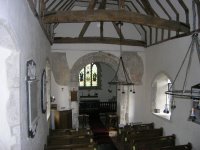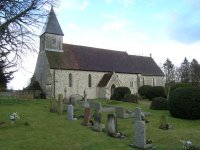 which suggests it needs changing as well as being a bit hotter. As we left floods of people came in, nine women in one party up to mischief no doubt and three business men. I hope they enjoyed their meal.
which suggests it needs changing as well as being a bit hotter. As we left floods of people came in, nine women in one party up to mischief no doubt and three business men. I hope they enjoyed their meal.ST ANDREW, MEONSTOKE
is picture postcard pretty but a rather ordinary building. That is not to say that I didn't like it -far from it. The tower looks like it needs to be in Herefordshire or Monmouthshire, but Tom tells me there is a little collection of similar towers in Hampshire. The nave and aisles are under a single roof, and hence the earlier clerestory of quatrefoils is now inside the church. The church is largely EE and C14 Dec, restored. The font is a Purbeck marble square on the usual five columns. I liked the pulpit, unusual with an outer arched extension with twisted columns. Pevsner doesn't mention it but Green (Churches of Hampshire) says it is late C17 with modern panels. The style dictated the rather cruder dumpier C19 choir stalls.
 The next church was reached by crossing the river and a very short walk.
The next church was reached by crossing the river and a very short walk.CORHAMPTON CHURCH
suffers from its main road situation but is for the large part a Saxon structure. No tower, and very difficult to photograph because of the large number of trees and steep fall of the site on three sides. Nave and chancel seperated by a big Saxon arch. There is a west gallery with a little organ under which is a tiny Norman font. The chancel has wall paintings which include on the south wall scenes from the life of St Swithin. Funny how the digital camera sees these better than your own eyes in natural or even electronic light.
Now it is typical of weather in England to be quirky but it now felt a little personal as the only time we had walked to a church (the car was five minutes away at Meonstoke pub carpark) the heavens opened! We spent longer at Corhampton until the storm passed.
 ST PETER & ST PAUL, EXTON
ST PETER & ST PAUL, EXTONAnother unplanned stop, as this was a church Tom had never visited. He is not keen to come back either! It is largely C13 heavily restored. The bell turret could be brand new but the likeliest date is C19. A few pretty moniments, one brought in from the churchyard. However it is the glass in the east window which is remarkable, Arts and Crafts yellows oranges and greens, d1891, unsigned. Another window is signed by E Stanley Watkins of Ealing, a new name to me, 1909, but entirely traditional (Jesus light of the world).
 ST JOHN THE EVANGELIST, WEST MEON
ST JOHN THE EVANGELIST, WEST MEONis a very early work by George Gilbert Scott, and a spacious interior, although rather spartan, is achieved here. The church stands on a new site just above the old churchyard where the medieval church stood (not a trace remains). Quite handsome and quite urban exterior. The interior has less of his fussiness of later years (foliage etc). From the old church the stone Royal Arms of 1712, now on top of awful partition white walls within the west end of the church where several rooms have been provided thus.
ALL SAINTS, EAST MEON
Probably one of the more famous churches of my day out, with its Norman crossing tower and beautiful setting against the South Downs in a picture postcard village. I cannot find the tower lovable, nor the church itself inside possibly thanks to the low crossing. However I was impressed by it all and saw one of the most precious fonts in the country.
 The church is cruciform with south aisle and south chapel, both with robust C13 arcades. The crossing alas is not open into the church as was the plan at Petersfield. The lasting memory is of the east window with glass by Sir Ninian Comper, figures of saints with much use of surrounding clear glass, 1921 and Tom's dislike of it, as well as the Black Tournai Marble font. This font has two sides of blank arcading (one with upper frieze of animals, the other with a frieze of dragons), and two sides telling the story of Adam & Eve. The giant fig leaves are rather hilarious. Royal Arms of 1613, very early.
The church is cruciform with south aisle and south chapel, both with robust C13 arcades. The crossing alas is not open into the church as was the plan at Petersfield. The lasting memory is of the east window with glass by Sir Ninian Comper, figures of saints with much use of surrounding clear glass, 1921 and Tom's dislike of it, as well as the Black Tournai Marble font. This font has two sides of blank arcading (one with upper frieze of animals, the other with a frieze of dragons), and two sides telling the story of Adam & Eve. The giant fig leaves are rather hilarious. Royal Arms of 1613, very early.ST MARY, BURITON
looks externally all rebuilt/restored and rather without interest. Inside it is a different story
 with long Norman arcades, that on the north with stepped arches and on the south double chamfered arches. The east window has very fine glass (= I liked it) by Powell & Sons. The westernmost window of the south aisle has glass of 2001 by Paul Quail, a millenium window which reminded us both of our last tour together in Sussex when I had panned the efforts of Up Waltham's Millenium Window. So is this one better? Was it worth the approach to the top 8 designers in the country, the invitation to the top four to come and speak to the villagers about their plans? Frankly no, not in my opinion. Wimpy colours, sentimental depictions of Jesus and Mary his mother with a long-winded flowery "concepts and symbology" plaque nearby - as a villager I would be very underwhelmed. Tom reserved public judgement - he has to continue to live locally!
with long Norman arcades, that on the north with stepped arches and on the south double chamfered arches. The east window has very fine glass (= I liked it) by Powell & Sons. The westernmost window of the south aisle has glass of 2001 by Paul Quail, a millenium window which reminded us both of our last tour together in Sussex when I had panned the efforts of Up Waltham's Millenium Window. So is this one better? Was it worth the approach to the top 8 designers in the country, the invitation to the top four to come and speak to the villagers about their plans? Frankly no, not in my opinion. Wimpy colours, sentimental depictions of Jesus and Mary his mother with a long-winded flowery "concepts and symbology" plaque nearby - as a villager I would be very underwhelmed. Tom reserved public judgement - he has to continue to live locally!So ended our tour together, with tea and cake from Pat his wife back at his. However as I was driving home I quickly realised that my phone was in the boot, so it was a good excuse to pull off
 the road to get it outside of
the road to get it outside ofST SIMON & ST JUDE, BRAMDEAN
The light was fading and I expected to find a locked door but no - it was open. No tower, nave and chancel with very deep southern transeptal extension making the church possibly wider than it is long. Not a huge amount to see here, but the chancel arch is late Norman.
All in all a very satisfactory tour, almost all done in the unexpected dry weather and even sunshine.



No comments:
Post a Comment